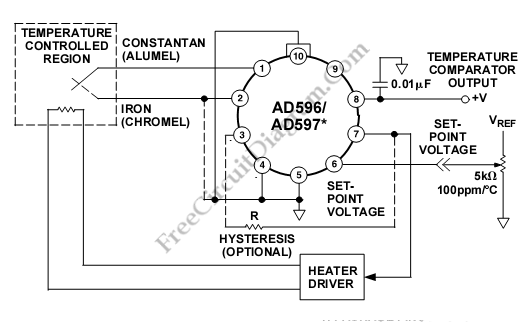
Setpoint Voltage of AD597 is °C × 10.1mV/°C – 9.1mV and Setpoint Voltage of AD596 is °C × 9.6mV/°C + 42mV. The setpoint pin of the AD596/AD597 has input impedance of about 50k. This resistance has temperature coefficient of ±15ppm/°C. This device has an additional ±1°C degradation of temperature stability over the +25°C to +100°C ambient temperature range due to 100ppm/°C 5k pot.
To increase system reliability and provide noise immunity, this device use Switching hysteresis. to enhanced system reliability, mechanical component wear is reduced by reducing the frequency of on-off cycling. It can be done by adding a single external resistor between Pins 7 and 3 of the AD596/AD597. The hysteresis is determined by following equation:
Rhyst=(Vout/200nA)*(1/°Chyst)
The alarm transistor will be ON regardless of whether there is an open circuit or not because the AD596/AD597 output is saturated at all times. for proper operationof the rest of the circuit, -ALM must be tied to a voltage below (+Vs – 4V) [Circuit's schematic diagram source: analog.com]


0 comments:
Post a Comment